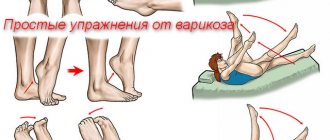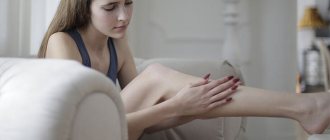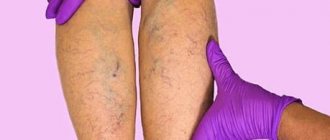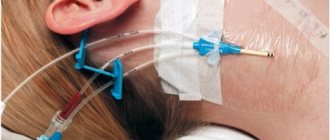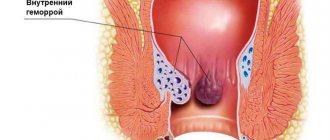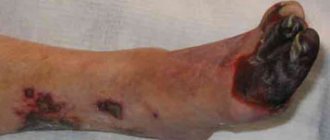Gymnastics for varicose veins is an effective method of preventing and treating the disease. It is also prescribed as a rehabilitation measure after surgical and medicinal correction.
Suitable exercises relieve fatigue and swelling in the legs, and significantly improve the appearance of the lower extremities. If you ignore the first manifestations of varicose veins, you may encounter serious problems such as protruding veins, seals and even trophic ulcers. It is extremely important to do gymnastics regularly - it does not take much time.
Reasons for the development of varicose veins
Varicose veins are a pathology that develops gradually. The etiology of the disease in each case is individual: genetic predisposition, sedentary lifestyle, unhealthy diet, wearing tight shoes, obesity, pregnancy, etc. The blood supply to the lower extremities is disrupted, as a result of which the walls of blood vessels are damaged. The first signs that you are developing varicose veins and it’s time to do leg exercises are:
- Discomfort in the legs. Many people attribute it to fatigue and put off going to the doctor until the veins begin to bulge strongly;
- Painful sensations after being in a static position;
- Feeling of burning, heaviness, itching in the area of visible veins;
- Swelling of the lower extremities in the evening;
- Vessels become visible on the legs - red, purple, blue;
- The skin on the lower legs darkens;
- The veins swell and become significantly larger, protruding above the skin.
If one or more symptoms appear, it is recommended to contact a phlebologist as soon as possible. If this is not possible at the moment, therapeutic exercises are the best solution to the problem.
How to improve blood circulation in the legs - ways
There are several ways to improve or restore blood circulation. First, conservative therapy is used. Appointed:
- diuretics that eliminate congestion;
- anticoagulants that prevent thrombosis (what products dissolve blood clots -) “Gaperin”;
- drugs that improve the walls of blood vessels (Anavelon);
- agents that restore blood flow (“Pentoxifylline”);
- phlebotonics that improve vascular tone (“Venarus”, “Detralex”, “Troxerutin”, “Phlebodia”);
- antiplatelet agents that restore blood circulation (“Thrombo-Ass”);
- statins (see), reducing cholesterol production (Atoris).
Other medications may be prescribed, however, they must be chosen by a doctor; some medications may be incompatible. You can massage with rosemary oil daily. This helps remove accumulated excess fluid. Additionally, physiotherapy is prescribed to help improve blood circulation. In advanced cases, it can only be restored through surgery.
With angioplasty, the affected vessels are replaced with artificial stents. Bypass surgery creates additional capillaries from the aorta. During sclerotherapy, a special solution is injected into the diseased vein. It dies, and the body creates a new one. Sometimes complete removal of the vessel is required.
The benefits of physical therapy
Regularly performing simple physical exercises will help:
- improve venous and lymphatic drainage;
- normalize arterial blood flow;
- restore the patency of the vascular bed in the damaged area;
- significantly reduce dystrophic changes in the tissues of the lower extremities;
- relieve heaviness in the legs, relieve swelling.
Also, exercise will help normalize skin tone, restore its healthy color, and stimulate regenerative processes in the deep layers of the epidermis.
Modern types of lymphatic drainage massage
Lymphatic drainage massage can be performed using hands, salon devices and simple massagers.
- Manual massage.
It can be superficial (capillaries and small vessels are treated) or deep (the effect also affects the lymph nodes, fat cells are broken down). - Hardware massage.
Done in the salon. There are different types:- Vacuum.
A vacuum pump is used. The effect of vacuum can be combined with a laser (laser-vacuum massage) or a roller (vacuum-roller massage: the nozzle creates a vacuum, and the roller inside it additionally massages the area captured by the device). - Pressotherapy.
Special pants or boots are put on, which are inflated with air and compress the problem area. - Microcurrents.
The legs are lubricated with a special solution, electrodes are attached to them, which release a pulsed current. - Simple massagers.
Lymphatic drainage massage of the legs can be performed independently at home. Vacuum cans and a dry brush are best for this. They are simple and convenient to work with.Both the jar and the brush are good at removing excess water, removing stagnation, melting fat, activating blood circulation and metabolism, tightening the skin, fighting cellulite, stretch marks, and spider veins.
Due to the vacuum, the jar gives a deeper effect (the pressure difference in the tissues works), but the brush completely removes dead epidermal cells, triggering skin renewal.
The costs for such a massager are minimal and cannot be compared with expensive salon procedures.
A wonderful Beauty365 natural bristle brush (hard cactus or soft boar) or a set of Beauty365 rubber MIRACLE cans will cost less than 1 thousand rubles (if you get a promotion on the website www.beauty365.ru).
Gymnastics for treatment
If you have been diagnosed with varicose veins, therapeutic exercises should become an integral part of your life. Here the exercises will be more difficult than in the case of preventive exercises. However, they must be performed if you want to consolidate the results of drug therapy and prevent the development of serious complications.
Physical exercise
- Lie on your back, lift your right leg up, and reach for it with your left hand. Then repeat the exercise with your left leg and right arm. The optimal load is 10-15 repetitions (look at your own feelings, if it’s hard, don’t overload the body).
- Lying on your back, bend your knees and press them to your stomach. In this position, raise your head and body, reaching towards your legs. Hold this pose for a few seconds, then relax and rest for 15-20 seconds.
- While lying down, lift your legs vertically and rotate your feet. Spend 5-7 minutes on this exercise.
- Sit on a chair. Place your arms behind the back of the chair, lift your legs with your knees bent, then straighten them horizontally. Bend your legs again and slowly lower. Do 5-10 approaches.
- Stand on a solid surface and begin to actively march. Bend your knees and try to lift them as high as possible.
- Finally, do one more simple exercise. Lie down, tense your legs and pull your toes as hard as possible so that you feel tension in your calf muscle. You need to do 5-10 approaches of 10 seconds.
No equipment or special devices are needed for classes. It is important that the surface on which you lie down is flat and moderately hard - you can lay a fitness mat or a regular blanket. The main thing is that the exercises do not bring discomfort or pain.
Breathing exercises
They are performed in conjunction with physical ones. You need to breathe deeply, measuredly. You should also alternate between diaphragmatic and chest breathing:
- Breathe deeply for a minute and gradually exhale. So that the chest rises.
- Then change tactics - breathe with your stomach connected. As you inhale, it should increase, and as you exit, it should decrease.
This will improve charging efficiency and saturate the tissues with oxygen.
Walking
Regular walking is the key to healthy feet. There is no need to go to extremes and walk everywhere exclusively. 30-60 minutes of leisurely walking a day will perfectly help cope with the signs of varicose veins.
Complex exercises
It is not at all necessary to perform all of the above exercises. Create the most optimal complex for yourself and spend 20-30 minutes a day on exercises. In addition to preventing varicose veins, exercise will help strengthen the leg muscles and tighten the skin.
Exercises for prevention
Prevention of varicose veins of the lower extremities consists of dosed, complex loads. An excellent method to prevent the development of the disease is swimming.
Here is a list of the most common exercises for the prevention of varicose veins, which are easy to perform at home:
- Sitting. Stretch your legs forward, perform circular movements with your feet clockwise and counterclockwise, repeat 10-15 times. Then place one foot on the toe, the other on the heel, alternate the position 10-15 times.
- Standing. Carefully rise to your toes, gradually lower to your heels, also 10-15 times. Then spread your legs shoulder-width apart and repeat the exercise. You can do 5-10 smooth squats.
- Lying down. A popular exercise is cycling - repeat the movements for 30-40 seconds. Then stretch your legs up, pointing your toes towards the ceiling. Keep your legs straight, slowly open and close them, 10-15 repetitions.
Absolute contraindications
- Diseases of the blood, heart, blood vessels: hemophilia, thrombosis, thrombophlebitis, aneurysm, heart valve defects, acute myocardial ischemia, severe sclerosis of cerebral vessels and some others.
- Renal, hepatic, pulmonary-heart failure.
- Serious mental illness.
- Pathologies of the lymphatic system.
- Diabetes.
- Active tuberculosis.
- Osteomyelitis (inflammation of the bone marrow).
- AIDS.
- Cancer, gangrene and other severe pathologies.
Additional recommendations
Even if you regularly perform physical exercises for varicose veins, do not expect an immediate effect. To eliminate the symptoms of the disease, you must also follow the following recommendations:
- Wear compression stockings. It significantly reduces pressure on the walls of blood vessels, relieves swelling and the feeling of fullness. However, you should use medical knitwear only according to a doctor’s indications - amateur efforts in this matter can lead to aggravation of the situation.
- Avoid being near a hot battery or open fire. Elevated temperatures interfere with normal blood circulation.
- Avoid eating excessively salty foods. If you have varicose veins, you should completely avoid table salt - it retains water in the body and interferes with normal fluid circulation.
- Take baths in the morning, not before bed. If possible, it is better to limit yourself to a shower.
- Watch your weight. In obese people, the load on all body systems, primarily the cardiovascular system, is significantly increased.
- Sleep - exclusively lying down. If you decide to take a nap on a sofa or chair, place your legs horizontally. Prolonged stay of the lower extremities in a vertical position significantly increases the load on the vascular bed.
In the treatment of varicose veins, an integrated approach is extremely important. Even surgery, sclerotherapy and other modern techniques will not give lasting results if the doctor’s recommendations are not followed.
Proper nutrition
If your blood circulation is poor, your legs may swell and get tired quickly. To prevent this from happening, it is recommended to follow a diet that will help improve and maintain vascular health.
Some foods prevent the deposition of cholesterol, slightly thin the blood, accelerate its circulation, and strengthen the walls of blood vessels:
- The amount of fatty foods should be limited to a minimum; it negatively affects the condition of blood vessels and the quality of blood circulation.
- Ginger is very useful. For example, you can try this drink: half a teaspoon of chopped ginger, twice as much honey and a small pinch of black pepper. All ingredients need to be poured with a glass of boiling water. This spicy medicine will stimulate blood flow and boost immunity.
- Add healthy spices to your food - garlic, horseradish, mustard, red and black pepper.
- In summer and autumn, do not miss the opportunity to dine on watermelon. The substance lycopene contained in it actively removes cholesterol from the body and activates blood circulation.
- Avoid consuming fast food, refined foods, carbonated drinks and drinks with high caffeine content.
- Eat more foods high in fiber - raw fruits and vegetables, grains.
- For good blood circulation, vitamin B is simply necessary. It is found in sufficient quantities in bread, especially black and coarsely ground, rolled oats, beans, lentils, nuts, especially pine nuts, fish
- You need to drink at least 8 glasses of regular clean water per day. This will prevent blood from thickening.
Proper balanced nutrition will help improve blood circulation, correct blood properties, and improve immunity. Along with the diet, it is recommended to give up bad habits such as smoking and drinking alcohol.
Exercises strictly contraindicated for varicose veins
There are a number of activities that can negate the entire positive effect of exercises for the treatment of varicose veins:
- Strength exercises with a barbell. To perform them, the body needs a huge amount of energy and resources. When lifting a barbell while standing, there is a possibility of permanently destroying the veins in your legs.
- Squats with weights. They lead to stagnation of blood in the legs and enormous pressure on the vascular bed of the lower extremities.
- Exercise bike. Absolutely not suitable for people with varicose veins.
- Jumping. When landing, bones, joints and soft tissues absorb the jump, and the lion's share of the load goes to the veins and blood vessels.
- Run. Even the most advanced treatment techniques will not help if you run regularly, especially on hard surfaces.
All of the above exercises only worsen varicose veins on the legs. They provoke blood stagnation, lead to a decrease in the elasticity of the veins, and significantly increase the risk of blood clots.
Exercises for varicose veins should only be prescribed by a specialized specialist. This could be a phlebologist with whom you are seeing, or an experienced rehabilitation therapist who cares for patients with problems of the cardiovascular system.
Still have questions about exercises for varicose veins?
Free consultation with AngioClinic specialists
Author
Salmina Daria Vladimirovna
Geneticist. Graduated from the Chelyabinsk State Medical Academy. She completed an internship at the Northwestern State Medical University named after I.I. Mechnikov.
What is lymphatic drainage massage
Lymphatic drainage massage is a manual or hardware effect on the body and face in order to restore lymphatic drainage.
Do you know what lymph is and why its unhindered flow is so important?
Lymph is a liquid that permeates our entire body along with blood. If the blood delivers nutrients and oxygen to the cells, then with the lymph everything unnecessary and harmful is “pumped out” from them: pathogenic microorganisms, toxins, waste products, end products of decay.
If the movement of lymph is disrupted, it accumulates in the body along with all the “garbage”. Due to its stagnation, toxins poison the body, the immune system weakens, and metabolism is disrupted. We feel a loss of strength and are constantly sick.
Externally this manifests itself in swelling. A bloated and flabby face with nasolabial lips and a double chin, a large belly, massive arms, “elephant” legs - all this is a consequence of stagnation of tissue fluid. It lingered between the cells instead of going through the channels of the lymphatic system for cleaning and partial utilization.
But you can give an impetus to the movement of lymph and remove obstacles in its path with the help of lymphatic drainage massage. It is done in the direction of lymph flow. What route is this? From bottom to top and from the periphery to the center. From the tips of the fingers and toes - to the area around the collarbones, where all the lymph collected throughout the body (already purified) flows into the neck veins, thus returning to the bloodstream.
Lymphatic drainage massage restores vascular patency, relieves spasms, and normalizes the activity of lymph nodes. And the lymph begins to flow uninterruptedly along its “transport routes.”

